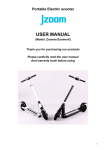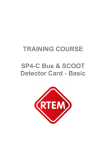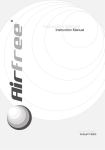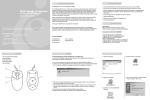Download User Manual - Boot Scoot Bikes
Transcript
USER’S MANUAL Warning: Please use common sense and caution when using this moving toy. Ensure riding environment is safe and unobstructed. Ensure all hardware is tight and operating properly before each use. Always wear protective equipment, including helmet and shoes, when using this product. Dear Customer, Thank you for purchasing a Boot Scoot. We know your child will enjoy riding their Boot Scoot. Safety should be your chief concern. Do not allow your child to use this toy until you have thoroughly read and understand this User's Manual. Safety: Children should always wear helmets and shoes when using this toy. Children should always use this toy under an adult’s supervision. Boot Scoot Bikes have no pedals. Children use their feet to brake and stop. Please ensure your child understands how to slow down and stop before riding. Ensure that all hardware is secure and tight before each use. If applicable, ensure that tires are inflated to the specified pressure. Ensure that the area where your child will be riding is safe and free of obstructions. Boot Scoot Bikes are intended for flat, level surfaces free of debris, ice, sand, gravel, etc. Not intended for use on roadways. If the vehicle or any of its parts becomes damaged, discontinue use until the damaged part(s) are replaced or properly repaired. Use only Boot Scoot Bike replacement parts. This is a child’s toy. Maximum suggested weight: 80 lbs. Liability: Boot Scoot Bikes Series of ESL Squared LLC is not responsible for unsafe operation of this ride-on toy, injuries incurred while using this ride-on toy, or any non-compliance of this User’s Manual. As with any physical exercise, bike riding can be a hazardous activity. Always supervise your child’s use of this toy. Boot Scoot Bike Parts List: Frame/Rear Fork Front Wheel Fork and Assembly Ball Bearings (2) 1 Chrome Collar Chrome Locking Nut Wheels (pre-assembled) Outer Cap Nut (4) Hook Ring (4) Inner nylon lock nut (4) Inner Chrome Spacer Tube (on Zoomer, Inner Bearing Casing on Cruiser—slightly different than in photo below but same basic assembly) (4) Chrome Ring Spacer-may or may not be notched as in photo Adjustable Seat Assembly Chrome Quick-Release pre-assembled on bike Handlebar with Grips Adjustable Lock Kit (preassembled) Allen wrench and mini-wrench for assembly 2 Assembly Instructions: Assembly tools (not supplied): 15mm socket or open-ended wrench, or adjustable wrench. PLEASE NOTE: Some of these steps may have been completed in the factory. However, please go through all steps and check pre-assembled parts to ensure precise assembly. 1. Open carton. Remove all contents and packaging from box. Ensure all parts are included using the above parts list. If any parts are missing, STOP. Contact Boot Scoot Bikes at www.BootScootBikes.com for replacement parts. 2. Place bike frame upright on a flat, level surface. 3. Insert seat assembly into seat post at desired height. Tighten quick-release by screwing nut onto bolt. NOTE: The rubber near the quick-release handle is contoured. It is important to tighten the nut as much as possible while holding the quick-release handle in place to avoid tearing the contoured rubber. Some minor tearing might occur, but will not affect the collar’s performance. NOTE: If you prefer not to use the quick-release feature, the quick-release collar provided can be used with a 1/4” nut and bolt set from your local hardware store. 4. Slide one ball bearing ring, BALL BEARINGS FACING UP, onto the front fork assembly. Slide the front fork assembly into the front frame. 5. Slide second ball bearing ring, BALL BEARINGS FACING DOWN, onto the inserted front fork assembly. 3 6. Screw chrome collar onto front frame assembly. Do not force. Collar should move smoothly when threaded correctly. Note: If you can tell the collar is threaded correctly, but it gets stuck and you cannot move it by hand, you may need to use an adjustable wrench to screw it onto the front frame assembly. 7. Screw or place ring spacer onto front frame assembly. (NOTE: Most models do not require this spacer. If there is not enough room to screw on the chrome locking nut in step 9, or if the chrome locking nut in step 9 fits flush onto the chrome collar without the spacer, leave the notched ring spacer aside. It will not affect the bike’s performance.) 8. Screw chrome locking nut onto top of front frame assembly. Again, do not force. Nut should move smoothly when threaded correctly, however, if you cannot move it by hand you can use an adjustable wrench to tighten it into place. 9. Remove protective plastic cap from handlebar assembly. (Make sure the ridged locking nut does not get stuck inside the protective plastic cap.) Insert handlebars with pre-assembled adjustable locking feature into the front frame/fork assembly to the desired height. Using the Allen wrench provided, tighten the handlebars into place. (Remember to readjust handlebars and seat height in the future as child grows.) 10. Turn frame upside down so that it rests on the seat and handlebars. 11. (If you are assembling a Cruiser, please scroll down to the “Attaching the Fenders” instructions at the end of these instructions. Once the fenders are attached, return to this step to attach the wheels.) 12. Locate one wheel assembly. Remove the protective plastic covers and discard. Remove the 4 two outer cap nuts and the hook rings, leaving the inner spacer tubes (or inner bearing casing for the Cruiser) and inner nylon lock nuts on the axle. 13. Ensure that the wheel axle is equal length on both sides of the wheel. Finger-tighten the nylon lock nuts. Do not over-tighten, inhibiting the wheel’s motion, or under-tighten allowing the wheel to wobble. 14. Install the wheel assembly in the front fork assembly. Then, insert the hook-rings onto the axle, on the outside of the forks. Place the hook ring tab into the hole on the fork assembly. Install the outer cap nuts onto the axle and tighten. NOTE: You can use the enclosed mini-wrench to tighten the cap nuts or you can use the enclosed mini-wrench to hold the inner bearing nuts in place while you tighten the outer nut with a 15mm socket or open-ended wrench (not supplied). 15. Repeat steps 13-16 with the second wheel on the rear fork assembly. 16. Try not to be too jealous when you hand the bike over to your child, but feel free to make friends and neighbors a little jealous just before you send them to www.BootScootBikes.com. REMEMBER: Children learn balance at their own pace. Most children begin by straddling the bike and just walking. Within a few weeks as they are encouraged and become more comfortable, they will begin sitting on the seat and will move a little faster. Soon they will learn to run with the bike and even lift their feet for short distances. Have fun!! SPECIAL INSTRUCTIONS FOR CRUISERS Attaching the Fenders: The Cruiser can be assembled with or without fenders. It will be easier to attach the fenders before the wheels, but can also be done after the wheels are attached. Parts included: 2 fenders 1 1/2” bolt with nut 1” bolt with nut Tools needed (not included): Philips-head screwdriver 10 mm Crescent wrench or adjustable wrench 5 mm Allen wrench/L-shaped hex key FRONT FENDER Assembly Instructions: 5 1. Choose the fender with the 1 1/2” bolt and nut set. Remove the nut and bolt. 2. Place the fender so that the beveled edge is toward the rear of the bike and the bracket touches the rear side of the front fork. (See front fender photo below.) 3. Insert the 1 1/2” bolt from the front of the fork through the holes and the bracket. Screw the nut on the bolt from the rear side of the fork and finger-tighten. (See front fender photo below.) 4. Using a 10mm crescent wrench to hold the nut in place, tighten the bolt with a 5 mm Allen wrench. REAR FENDER Assembly instructions: 1. Choose the fender with the 1” bolt and nut set. Remove the nut and bolt. 2. Place the fender so that the beveled edge is toward the rear of the bike and the bracket lies on top of the bar spanning the rear fork. 3. Insert the 1” bolt from the top of the bike through the bracket and the holes on the bar. (See rear fender photo below.) Screw the nut on the bolt from the bottom side of the bar and finger-tighten. 4. Using a 10mm crescent wrench to hold the nut in place, tighten the bolt with a Philips-head screwdriver. Once the fenders are attached, please return to step 13 in the main instructions. Front Fender Rear Fender 6











